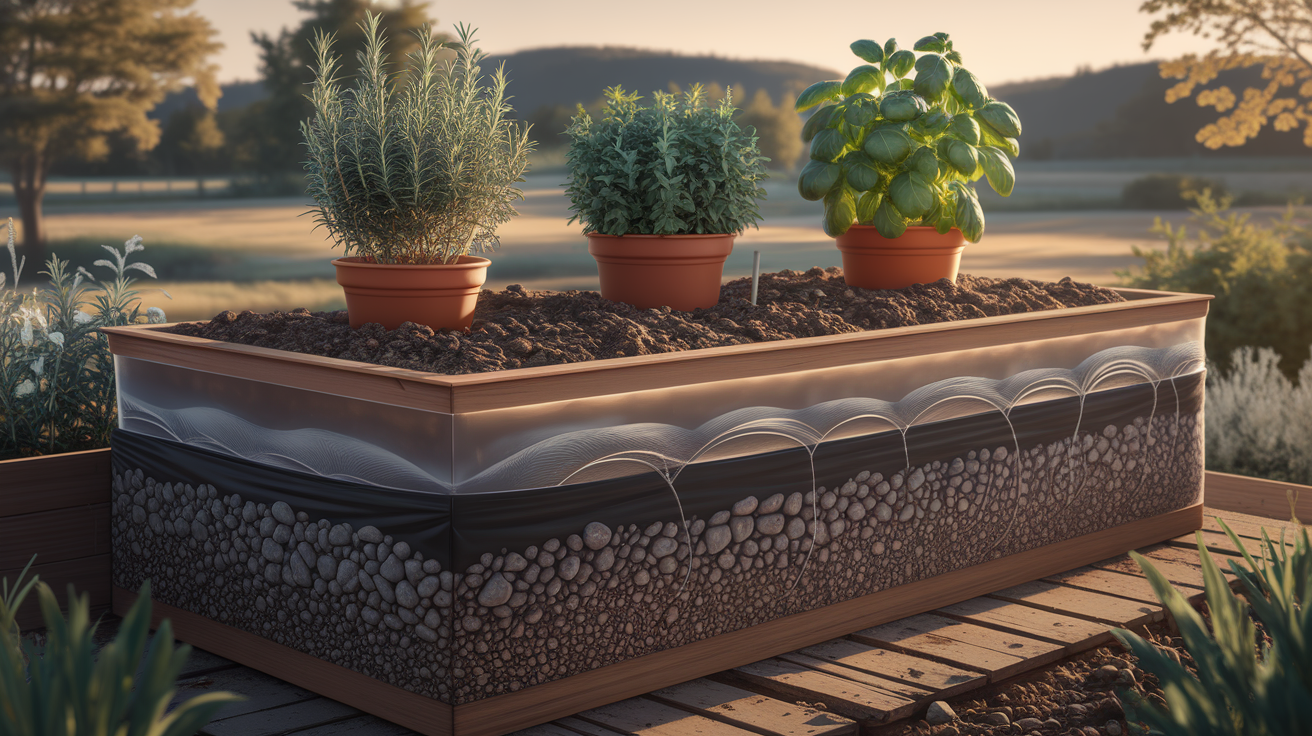Welcome to Rhys Garden, your trusted companion in the world of innovative gardening solutions. Today, we’re diving deep into the enchanting realm of self-watering garden beds – a game-changer for both novice gardeners and seasoned green thumbs alike. These ingenious creations are transforming the way we nurture our plants, offering a harmonious blend of efficiency, sustainability, and botanical bliss.
What Are Self-Watering Garden Beds?
Self-watering garden beds, often called sub-irrigated planters or SIPs, are a modern marvel in the horticultural world. These clever containers have revolutionized the way we approach plant care, providing a consistent and optimal moisture level for your beloved flora.
At its core, a self-watering garden bed consists of two main components:
- The growing chamber: This upper section holds your soil and plants.
- The water reservoir: Located beneath the growing chamber, this area stores water for continuous irrigation.
These two sections are separated by a wicking system, which allows water to move upwards into the soil through capillary action – much like how a sponge absorbs water. This ingenious design ensures that your plants receive a steady supply of moisture, reducing the need for frequent watering and minimizing the risk of over or under-watering.
Benefits of Self-Watering Garden Beds

Water Conservation
In an era where water conservation is paramount, self-watering garden beds shine as beacons of sustainability. By delivering water directly to the roots and reducing evaporation, these systems can save up to 80% more water compared to traditional gardening methods. This not only helps preserve our precious water resources but also translates to lower water bills for eco-conscious gardeners.
Time-Saving Convenience
For busy urban dwellers or those with hectic schedules, self-watering garden beds are a godsend. Gone are the days of daily watering routines or worrying about your plants while you’re away on vacation. Depending on the size of your reservoir and the water needs of your plants, you might only need to refill the water chamber every 1-2 weeks.
Optimal Plant Growth
The consistent moisture level provided by self-watering systems creates an ideal environment for root development. Plants in these beds often grow faster, stronger, and produce higher yields compared to those in traditional containers. The steady water supply also helps prevent stress-related issues like blossom end rot in tomatoes or bitter lettuce.
Versatility in Placement
Whether you have a sprawling backyard or a cozy balcony, self-watering garden beds can fit into any space. Their contained nature makes them perfect for urban gardening, rooftop gardens, or even indoors near a sunny window. This flexibility allows you to grow your favorite herbs, vegetables, or flowers regardless of your living situation.
Reduced Soil Compaction
Traditional watering methods can lead to soil compaction over time, which hinders root growth and nutrient uptake. Self-watering beds eliminate this issue by watering from the bottom up, maintaining a loose, aerated soil structure that’s conducive to healthy root development.
Types of Self-Watering Garden Beds
Standalone Containers
These are individual pots or planters with built-in self-watering mechanisms. They’re ideal for small spaces or for growing single plants like tomatoes or peppers.
Raised Bed Systems
Larger self-watering raised beds are perfect for outdoor vegetable gardens or flower beds. They offer ample growing space while maintaining the benefits of self-watering technology.
Vertical Systems
For those looking to maximize space, vertical self-watering gardens are an excellent choice. These can be wall-mounted or freestanding, allowing you to grow a variety of plants in a compact area.
DIY Options
For the crafty gardener, there are numerous DIY self-watering bed designs available. These range from simple bucket systems to more complex raised bed constructions using materials like wood, plastic, or metal.
How to Choose the Right Self-Watering Garden Bed
Selecting the perfect self-watering garden bed depends on several factors:
- Space available: Consider the size of your gardening area and choose a system that fits comfortably.
- Plants you want to grow: Different plants have varying water needs and root depths. Ensure your chosen bed can accommodate your desired flora.
- Material: Look for durable, UV-resistant materials if placing outdoors.
- Reservoir capacity: Larger reservoirs mean less frequent refilling but may be heavier when full.
- Aesthetic: Choose a design that complements your outdoor or indoor decor.
Setting Up Your Self-Watering Garden Bed
Choosing the Right Location
Select a spot that receives adequate sunlight for your chosen plants. Most vegetables and herbs require at least 6 hours of direct sunlight daily. Consider proximity to a water source for easy refilling.
Preparing the Bed
- If using a new bed, rinse it thoroughly to remove any manufacturing residues.
- Install the wicking system according to the manufacturer’s instructions.
- Fill the reservoir with water.
Selecting the Right Soil
Use a high-quality potting mix specifically designed for container gardening. Avoid garden soil, which can become compacted and hinder proper wicking. A good mix should:
- Be well-draining
- Contain organic matter for nutrient retention
- Have a balanced pH (around 6.0-7.0 for most plants)
Planting Your Garden
- Fill the growing chamber with your chosen potting mix, leaving about an inch of space at the top.
- Plant your seedlings or seeds according to their specific requirements.
- Water thoroughly from the top to establish initial soil moisture.
Maintenance Tips
- Check the water level indicator regularly and refill as needed.
- Fertilize your plants as you would in a traditional garden, but be cautious not to over-fertilize, as nutrients aren’t washed away as quickly in self-watering systems.
- Clean the reservoir and wicking system annually to prevent algae growth and mineral buildup.
Plant Selection for Self-Watering Garden Beds
While most plants thrive in self-watering systems, some are particularly well-suited:
Vegetables
- Tomatoes
- Peppers
- Eggplants
- Leafy greens (lettuce, spinach, kale)
- Herbs (basil, cilantro, parsley)
Flowers
- Petunias
- Marigolds
- Impatiens
- Begonias
- Geraniums
Avoiding Overwatering
While self-watering beds are designed to provide optimal moisture, some plants prefer drier conditions. Be cautious with:
- Succulents and cacti
- Mediterranean herbs like rosemary and thyme
- Plants prone to root rot, such as some orchid varieties
For these plants, consider modifying your self-watering bed to allow for less frequent watering or choose traditional containers instead.
Troubleshooting Common Issues
Algae Growth
If you notice green algae in your reservoir:
- Clean the reservoir thoroughly
- Use an opaque cover to block sunlight
- Consider adding a small amount of hydrogen peroxide to the water
Nutrient Deficiencies
If plants show signs of yellowing leaves or stunted growth:
- Ensure you’re using a well-balanced fertilizer
- Consider occasional top-watering to flush excess salts from the soil
Pest Problems
Self-watering beds can sometimes create a humid environment attractive to pests. To combat this:
- Ensure good air circulation around your plants
- Regularly inspect for signs of infestation
- Use organic pest control methods when necessary
The Environmental Impact of Self-Watering Garden Beds
As we face increasing environmental challenges, self-watering garden beds offer a sustainable solution for home gardeners:
Water Conservation
By reducing water waste through evaporation and runoff, these systems play a crucial role in water conservation efforts. A study by the University of Illinois found that self-watering containers used up to 80% less water than traditional pots.
Reduced Chemical Runoff
The closed system of self-watering beds minimizes the leaching of fertilizers and pesticides into the surrounding environment, protecting local ecosystems and waterways.
Urban Greening
Self-watering beds make it easier for city dwellers to maintain plants, contributing to urban greening efforts. This increase in vegetation can help combat the urban heat island effect and improve air quality.
The Future of Self-Watering Technology
As gardening technology continues to evolve, we’re seeing exciting developments in self-watering systems:
Smart Integration
New models are incorporating smart technology, allowing gardeners to monitor water levels, soil moisture, and even nutrient content via smartphone apps.
Sustainable Materials
Manufacturers are exploring eco-friendly materials for bed construction, such as recycled plastics or biodegradable composites.
Hydroponics Hybrids
Some innovative designs are blending self-watering technology with hydroponic principles, creating ultra-efficient growing systems for the home gardener.
Frequently Asked Questions
1. How often do I need to refill my self-watering garden bed?
The frequency depends on factors like bed size, plant type, and weather conditions. Generally, you might need to refill every 1-2 weeks, but always check the water level indicator regularly.
2. Can I use self-watering beds for indoor plants?
Absolutely! Self-watering beds are excellent for indoor use, especially for those who travel frequently or tend to forget regular watering.
3. Are self-watering garden beds suitable for vegetable gardening?
Yes, they’re ideal for many vegetables, especially those with consistent water needs like tomatoes, peppers, and leafy greens.
4. How do I prevent mosquitoes from breeding in the water reservoir?
Ensure your reservoir is properly covered and consider adding a few drops of food-grade vegetable oil to the surface of the water, which prevents mosquitoes from laying eggs.
5. Can I use rainwater in my self-watering garden bed?
Yes, rainwater is excellent for self-watering systems. Consider setting up a rain barrel to collect rainwater for your beds.
Conclusion: Embracing the Self-Watering Revolution
Self-watering garden beds represent a harmonious blend of technology and nature, offering a solution that’s both environmentally conscious and user-friendly. Whether you’re a busy professional looking to maintain a small herb garden or an enthusiastic horticulturist aiming to maximize your vegetable yield, these innovative systems provide a pathway to gardening success.
At Rhys Garden, we believe that everyone should have the opportunity to experience the joy of nurturing plants, regardless of their schedule or living situation. Self-watering garden beds make this dream a reality, opening up a world of possibilities for urban gardeners, busy families, and anyone looking to add a touch of green to their lives.
As we continue to face environmental challenges and urbanization, the importance of sustainable, efficient gardening solutions cannot be overstated. Self-watering garden beds not only conserve our precious water resources but also encourage more people to engage with nature, fostering a greater connection to the food we eat and the world around us.
We invite you to explore the world of self-watering garden beds and discover how they can transform your gardening experience. Whether you’re taking your first steps into the world of plants or looking to optimize your existing garden, these innovative systems offer a path to greener, more sustainable living.
Remember, every plant nurtured, every vegetable harvested, and every flower that blooms is a small victory for our planet. With self-watering garden beds, you’re not just growing plants; you’re cultivating a more sustainable future, one garden at a time.
Happy gardening, and may your thumbs always be green!

Related Posts
Are Wild Flowers Perennial? Unveiling Nature’s Blooming Secrets
Growing Johnny Jump Up Seeds: A Gardener’s Guide to Viola Tricolor
The Art of Transplanting Japanese Maple